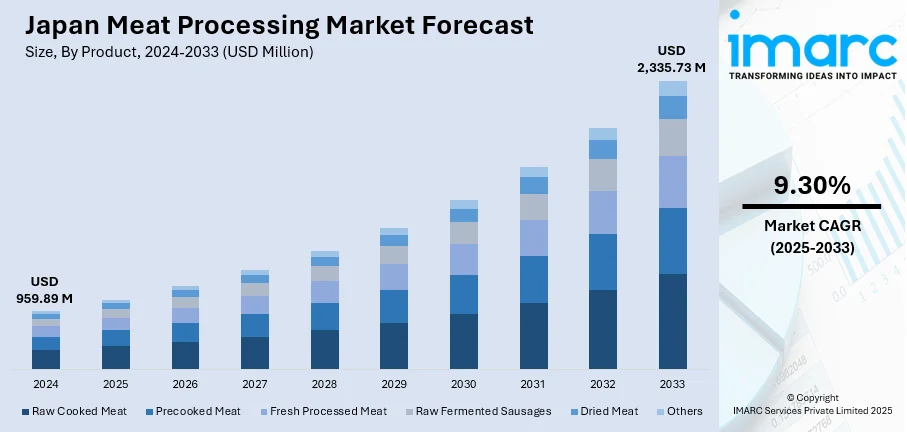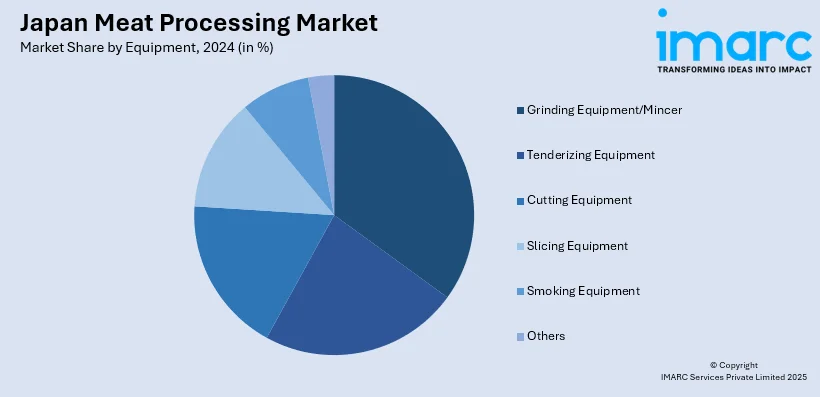
Japan Meat Processing Market Size, Share, Trends and Forecast by Product, Equipment, Meat, Mode of Operation, and Region, 2025-2033
Japan Meat Processing Market Overview:
The Japan meat processing market size reached USD 959.89 Million in 2024. Looking forward, IMARC Group expects the market to reach USD 2,335.73 Million by 2033, exhibiting a growth rate (CAGR) of 9.30% during 2025-2033. Rising consumer demand for convenient and ready-to-eat protein sources, along with advancements in food safety technologies and cold chain logistics, are key drivers of the market. Additionally, increasing domestic consumption of processed poultry and pork is further contributing to the expansion of Japan meat processing market share.
|
Report Attribute
|
Key Statistics
|
|---|---|
|
Base Year
|
2024
|
|
Forecast Years
|
2025-2033
|
|
Historical Years
|
2019-2024
|
| Market Size in 2024 | USD 959.89 Million |
| Market Forecast in 2033 | USD 2,335.73 Million |
| Market Growth Rate 2025-2033 | 9.30% |
Japan Meat Processing Market Trends:
Shift Toward Functional and Value-Added Meat Products
One of the prominent trends driving the market is the rising demand for functional and value-added meat products. Japanese consumers are increasingly seeking meat items that offer health benefits such as high protein, low fat, and enhanced nutritional profiles. This has led to innovation in product formulations, including the use of enriched ingredients like omega-3 fatty acids, collagen, and dietary fiber. Food processors are leveraging advanced technologies such as vacuum tumbling and marination systems to create products that align with evolving health-conscious consumer preferences. Moreover, premiumization of meat offerings, driven by a growing interest in artisanal and locally sourced products, is helping brands differentiate in a mature market. This shift contributes significantly to shaping a more sophisticated and health-oriented Japan meat processing market. For instance, in March 2025, Texas-based NSC Beef Processing showcased its patented spinal cord-free beef processing technology at a global meat industry conference in Japan. The innovation, developed by owner Gary Hendrix, aims to produce safer, cleaner beef by eliminating spinal cord contamination, a known source of harmful substances. The method is 30–50% faster and cools meat more efficiently than current standards. NSC hopes to attract international partners, particularly in Japan, by promoting the health and efficiency benefits of their advanced deboning process.

To get more information on this market, Request Sample
Integration of Robotics and Smart Processing Technologies
The integration of robotics and smart manufacturing solutions represents a critical trend in the Japan meat processing market growth. Facing an aging workforce and labor shortages, Japanese meat processors are increasingly automating production lines using robotics for tasks such as cutting, deboning, and packaging. Artificial intelligence and machine vision are being deployed to improve accuracy, reduce waste, and enhance hygiene standards throughout the processing chain. These innovations not only optimize operational efficiency but also support traceability and compliance with stringent food safety regulations. As Industry 4.0 technologies become more prevalent, companies are investing in real-time monitoring systems and data-driven decision-making platforms, thus reinforcing Japan’s position as a technologically advanced player in meat processing. This digital transformation is vital to the competitiveness of the Japan meat processing market. For instance, in February 2025, Japan announced that it will be investing JPY1.2 Billion from its 2025 budget to form a national consortium aimed at modernising its domestic meat industry. The initiative targets restructuring the meat supply chain, including processing, trading, and distribution, while modernising facilities with advanced, labour-saving technology.
Japan Meat Processing Market Segmentation:
IMARC Group provides an analysis of the key trends in each segment of the market, along with forecasts at the country and regional levels for 2025-2033. Our report has categorized the market based on product, equipment, meat, and mode of operation
Product Insights:
- Raw Cooked Meat
- Precooked Meat
- Fresh Processed Meat
- Raw Fermented Sausages
- Dried Meat
- Others
The report has provided a detailed breakup and analysis of the market based on the product. This includes raw cooked meat, precooked meat, fresh processed meat, raw fermented sausages, dried meat, and others.
Equipment Insights:

- Grinding Equipment/Mincer
- Tenderizing Equipment
- Cutting Equipment
- Slicing Equipment
- Smoking Equipment
- Others
A detailed breakup and analysis of the market based on the equipment have also been provided in the report. This includes grinding equipment/mincer, tenderizing equipment, cutting equipment, slicing equipment, smoking equipment, and others.
Meat Insights:
- Beef
- Pork
- Mutton
- Others
The report has provided a detailed breakup and analysis of the market based on the meat. This includes beef, pork, mutton, and others.
Mode of Operation Insights:
- Manual
- Semi-Automatic
- Automatic
A detailed breakup and analysis of the market based on the mode of operation have also been provided in the report. This includes manual, semi-automatic, and automatic.
Regional Insights:
- Kanto Region
- Kansai/Kinki Region
- Central/Chubu Region
- Kyushu-Okinawa Region
- Tohoku Region
- Chugoku Region
- Hokkaido Region
- Shikoku Region
The report has also provided a comprehensive analysis of all the major regional markets, which include Kanto Region, Kansai/Kinki Region, Central/Chubu Region, Kyushu-Okinawa Region, Tohoku Region, Chugoku Region, Hokkaido Region, and Shikoku Region.
Competitive Landscape:
The market research report has also provided a comprehensive analysis of the competitive landscape. Competitive analysis such as market structure, key player positioning, top winning strategies, competitive dashboard, and company evaluation quadrant has been covered in the report. Also, detailed profiles of all major companies have been provided.
Japan Meat Processing Market News:
- In February 2025, Japanese conglomerate Sojitz Corp inaugurated a state-of-the-art beef processing facility in Vietnam’s Vinh Phuc Province. Positioned as the country’s largest, the plant is designed to handle up to 30,000 cattle annually and produce approximately 10,000 tons of beef. The facility emphasizes chilled beef production in a sanitized, temperature-controlled environment. The company plans to distribute high-quality beef through cold-chain logistics targeting upscale hotels, restaurants, and retail outlets across the Vietnamese market.
- In August 2024, New Zealand's Verkerks sold its Ashburton abattoir to Japan’s SFJ Holdings for NZ$15 Million. The deal includes 37 hectares of land and full ownership of Ashburton Meat Processors. SFJ, a subsidiary of Japan’s S Foods, plans to expand the plant to process Wagyu beef.
- In April 2024, Atlantic Beef Products (ABP) in Prince Edward Island secured its first beef export deal with Japan after attending Foodex 2024 in Tokyo. The company will ship three containers, each with 24 tonnes of frozen beef, to meet Japanese demand for thin-sliced cuts.
Japan Meat Processing Market Report Coverage:
| Report Features | Details |
|---|---|
| Base Year of the Analysis | 2024 |
| Historical Period | 2019-2024 |
| Forecast Period | 2025-2033 |
| Units | Million USD |
| Scope of the Report |
Exploration of Historical Trends and Market Outlook, Industry Catalysts and Challenges, Segment-Wise Historical and Future Market Assessment:
|
| Products Covered | Raw Cooked Meat, Precooked Meat, Fresh Processed Meat, Raw Fermented Sausages, Dried Meat, Others |
| Equipments Covered | Grinding Equipment/Mincer, Tenderizing Equipment, Cutting Equipment, Slicing Equipment, Smoking Equipment, Others |
| Meats Covered | Beef, Pork, Mutton, Others |
| Mode of Operations Covered | Manual, Semi-Automatic, Automatic |
| Regions Covered | Kanto Region, Kansai/Kinki Region, Central/Chubu Region, Kyushu-Okinawa Region, Tohoku Region, Chugoku Region, Hokkaido Region, Shikoku Region |
| Customization Scope | 10% Free Customization |
| Post-Sale Analyst Support | 10-12 Weeks |
| Delivery Format | PDF and Excel through Email (We can also provide the editable version of the report in PPT/Word format on special request) |
Key Questions Answered in This Report:
- How has the Japan meat processing market performed so far and how will it perform in the coming years?
- What is the breakup of the Japan meat processing market on the basis of product?
- What is the breakup of the Japan meat processing market on the basis of equipment?
- What is the breakup of the Japan meat processing market on the basis of meat?
- What is the breakup of the Japan meat processing market on the basis of mode of operation?
- What is the breakup of the Japan meat processing market on the basis of region?
- What are the various stages in the value chain of the Japan meat processing market?
- What are the key driving factors and challenges in the Japan meat processing market?
- What is the structure of the Japan meat processing market and who are the key players?
- What is the degree of competition in the Japan meat processing market?
Key Benefits for Stakeholders:
- IMARC’s industry report offers a comprehensive quantitative analysis of various market segments, historical and current market trends, market forecasts, and dynamics of the Japan meat processing market from 2019-2033.
- The research report provides the latest information on the market drivers, challenges, and opportunities in the Japan meat processing market.
- Porter's five forces analysis assist stakeholders in assessing the impact of new entrants, competitive rivalry, supplier power, buyer power, and the threat of substitution. It helps stakeholders to analyze the level of competition within the Japan meat processing industry and its attractiveness.
- Competitive landscape allows stakeholders to understand their competitive environment and provides an insight into the current positions of key players in the market.
Need more help?
- Speak to our experienced analysts for insights on the current market scenarios.
- Include additional segments and countries to customize the report as per your requirement.
- Gain an unparalleled competitive advantage in your domain by understanding how to utilize the report and positively impacting your operations and revenue.
- For further assistance, please connect with our analysts.
 Request Customization
Request Customization
 Speak to an Analyst
Speak to an Analyst
 Request Brochure
Request Brochure
 Inquire Before Buying
Inquire Before Buying




.webp)




.webp)












